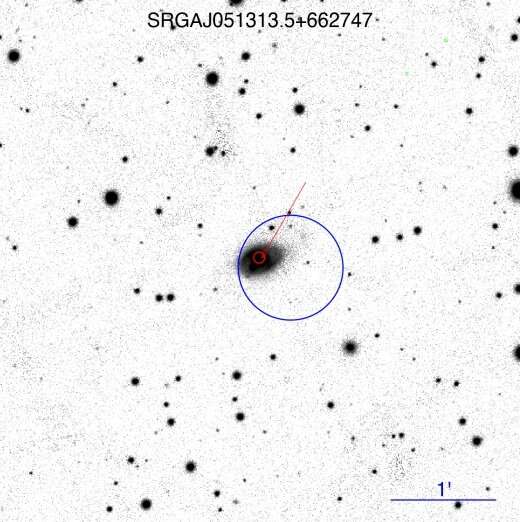June 27, 2023 report
Researchers detect 14 new active galactic nuclei

Tomasz Nowakowski
astronomy writer

Using the Spectrum–RG (SRG) spacecraft and two ground-based telescopes, Russian astronomers have observed X-ray sources in the eastern Galactic sky. The observational campaign resulted in the detection of 14 new active galactic nuclei. The findings were presented June 6 in the journal Astronomy Letters.
An active galactic nucleus (AGN) is a compact region at the center of a galaxy, more luminous than the surrounding galaxy light. AGNs are very energetic due either to the presence of a black hole or star formation activity at the core of the galaxy.
Astronomers generally divide AGNs into two groups based on emission line features. Type 1 AGNs show broad and narrow emission lines, while only narrow emission lines are present in Type 2 AGNs.
Recently, a team of astronomers led by Grigory Uskov of the Russian Academy of Sciences in Moscow, has investigated hard X-ray sources in the eastern Galactic half of the sky. For this purpose, they employed SRG's ART-XC and eROSITA telescopes, as well as the 1.6-m AZT-33IK telescope at the Sayan Observatory in Russia and the 1.5-m Russian–Turkish telescope (RTT-150) at the TUBITAK National Observatory in Turkey.
"We present the results of our identification of 14 X-ray sources detected in the eastern Galactic sky (0 < l < 180°) in the 4–12 keV energy band on the combined map of the first five all-sky surveys (from December 2019 to March 2022) with the Mikhail Pavlinsky ART-XC telescope onboard the SRG observatory," the researchers wrote in the paper.
The study detected 14 new AGNs relatively nearby, at redshifts between 0.015 and 0.238. They all are hosted by Seyfert galaxies—one of the NLSy1 type, three of the Sy1 type, four were classified as Sy1.9, and six as Sy2. The X-ray luminosities of these active galactic nuclei were measured to be within the range of 1–100 tredecillion erg/s, which is typical for AGNs at the present epoch.
The astronomers constructed broadband (0.2–12 keV) X-ray spectra and managed to derive black hole masses and bolometric luminosities for four of the newfound AGNs. These values were found to be 12–260 million solar masses, and 170–1,800 tredecillion erg/s, respectively. They also found that in four AGNs the intrinsic absorption exceeds 1,022 cm−2.
Summing up the results, the authors of the paper noted how important their discovery is for the ongoing AGN search. They hope to build a large sample of these objects based on their hard X-ray emission.
"The result obtained will help to obtain a large (about 2,000 objects), statistically complete sample of AGNs selected by their emission in the hard 4–12 keV X-ray energy band on completion of the planned eight sky surveys," the researchers concluded.
Written for you by our author —this article is the result of careful human work. We rely on readers like you to keep independent science journalism alive. If this reporting matters to you, please consider a (especially monthly). You'll get an ad-free account as a thank-you.
More information: G. S. Uskov et al, New Active Galactic Nuclei Detected by the ART-XС and eROSITA Telescopes during the First Five SRG All-Sky X-ray Surveys, Astronomy Letters (2023). . On arXiv:
Journal information: arXiv
© 2023 Science X Network





















